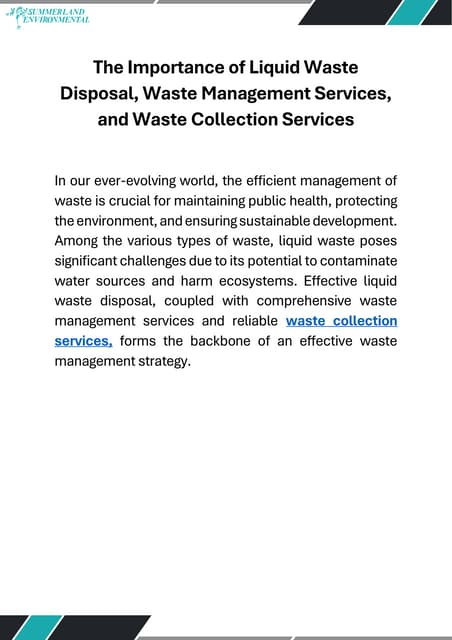Fascination About Reclaim Waste
Fascination About Reclaim Waste
Blog Article
How Reclaim Waste can Save You Time, Stress, and Money.
Table of ContentsReclaim Waste Fundamentals ExplainedMore About Reclaim Waste9 Easy Facts About Reclaim Waste ShownWhat Does Reclaim Waste Do?6 Easy Facts About Reclaim Waste Shown
Residential sewer waste refers to the waste and products from a household septic storage tank. The appropriate monitoring and disposal of residential sewage waste call for fluid waste to be transferred to a sewer treatment plant where the correct techniques and equipment are used to purify and dispose of waste.
Industrial waste commonly includes prospective hazards, such as flammable products or a combination of liquid and strong waste products, and calls for an extra innovative and in-depth disposal process. The disposal of commercial waste generally includes the purification of waste before transport to guarantee risk-free and appropriate disposal. Hazardous waste is produced from results and runoff of industrial processes and production.
This sort of waste can not make use of the exact same sewage monitoring transport or procedures as septic or business liquids. The commercial waste management procedure calls for the examination and testing of liquid waste prior to it goes through the disposal process (liquid waste removal melbourne). Runoff waste is the fluid waste that comes from runoff and excess stormwater in very populated areas or cities
Runoff waste can trigger contamination and flooding if not handled appropriately. Making certain appropriate waste management can prevent disasters and lower ecological harm.
3 Simple Techniques For Reclaim Waste
Call PROS Providers today to find out about our waste monitoring and disposal solutions and the appropriate methods to take care of the liquid waste you generate.
(https://telegra.ph/Expert-Liquid-Waste-Disposal-and-Removal-Services-in-Melbourne-11-12)This supposed 'wastewater' is not just a vital source however, after therapy, will certainly be launched to our land, rivers or the sea. Made use of water from bathrooms, showers, baths, kitchen area sinks, laundries and industrial processes is known as wastewater.

water made use of to cool down equipment or clean plant and equipment). Stormwater, a form of wastewater, is drainage that flows from farming and metropolitan areas such as roofings, parks, yards, roadways, paths and rain gutters into stormwater drains pipes, after rainfall. Stormwater streams untreated straight to neighborhood creeks or rivers, at some point reaching the ocean.
Getting The Reclaim Waste To Work
In Queensland, the majority of wastewater is dealt with at sewage treatment plants. Wastewater is delivered from domestic or industrial sites with a system of drains and pump stations, referred to as sewage reticulation, to a sewer treatment plant. Local federal governments construct, keep and operate most sewer therapy plants. Operators are certified under the Environmental Management Act 1994 to discharge cured wastewater at an acceptable environmental criterion into rivers.
The Department of Natural Resources recommends neighborhood federal governments regarding managing, operating and maintaining sewage systems and therapy plants. In unsewered areas, city governments may call for homeowners to set up individual or house sewer therapy systems to treat domestic wastewater from commodes, kitchen areas, bathrooms and laundries. The Division of Natural Resources authorizes using household systems when they are verified to be efficient.
In some new communities, therapy of some stormwater to eliminate litter, sand and gravel has begun utilizing gross pollutant catches. Wastewater treatment takes place in four phases: Removes strong matter.
Uses little living microorganisms understands as micro-organisms to break down and remove staying liquified wastes and fine bits. Micro-organisms and wastes are included in the sludge.
The Reclaim Waste Ideas
Nutrient elimination is not visit this site offered at all sewer therapy plants due to the fact that it needs expensive specialist equipment. Clear liquid effluent produced after therapy might still have disease-causing micro-organisms - liquid waste removal melbourne.

Most wastewater moves into the sewage system. Under the Act, local federal governments provide authorizations and licences for eco relevant tasks (ERAs) entailing wastewater releases that could have a regional influence.
Reclaim Waste - Questions
Otherwise, samples are taken for lab evaluation. Typically several tests are needed to establish the levels of each of the different toxins such as oils, hefty metals and pesticides in water. Tracking supplies valid details about water high quality and can verify that permit problems are being fulfilled. The information obtained with surveillance provides the basis for making water quality decisions.
Report this page